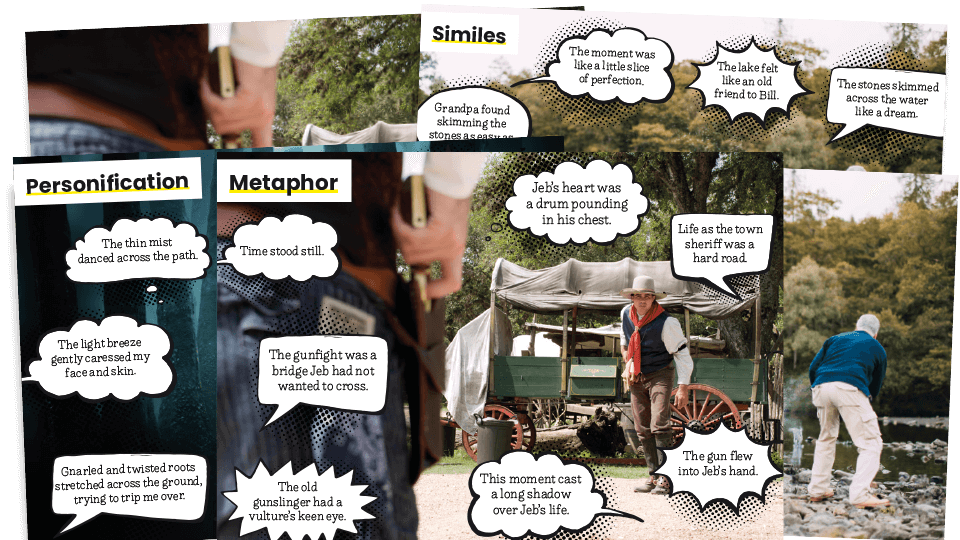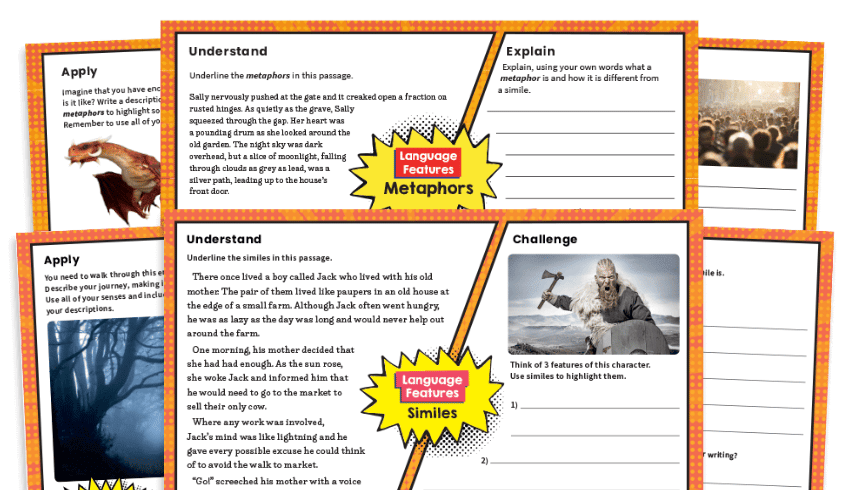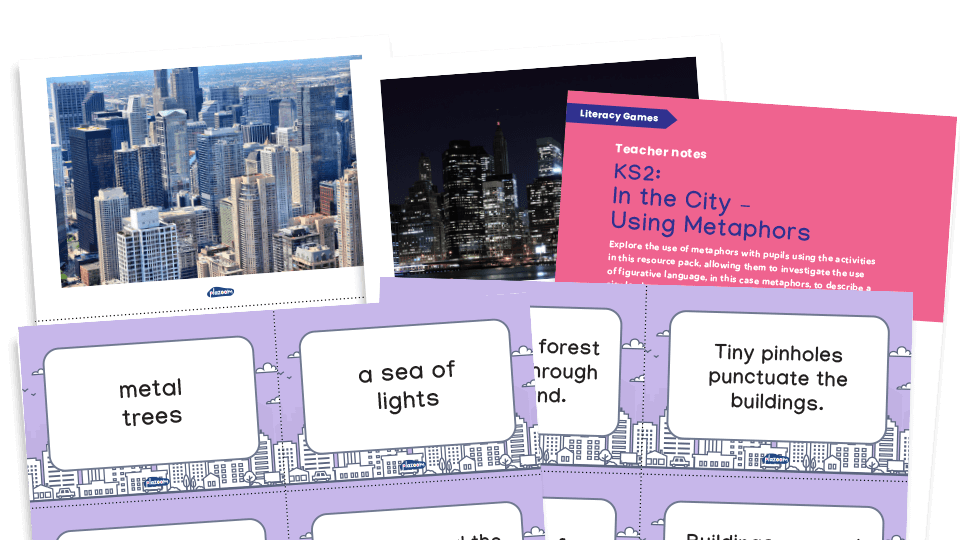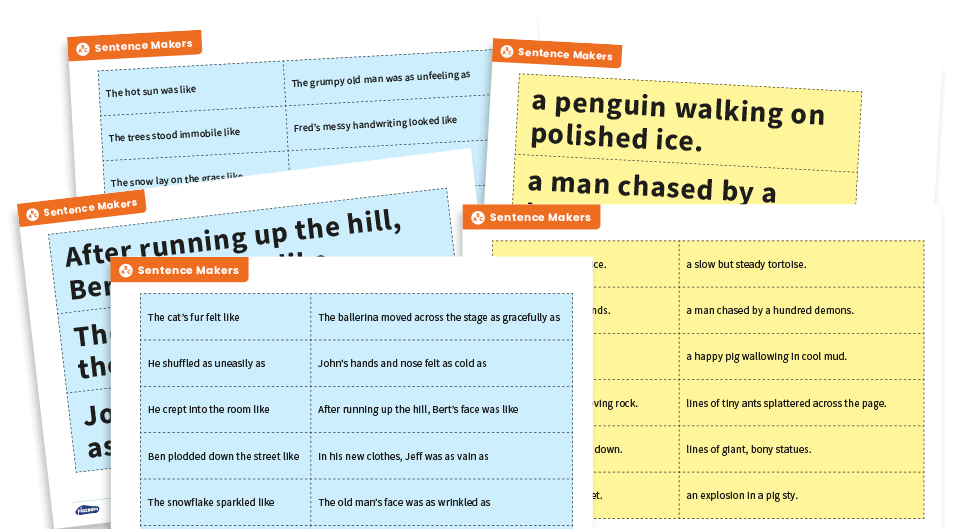Similes and metaphors are key features of descriptive language in KS2. The question is, are you confident that you can help your pupils to weave each literary device seamlessly into their writing?
Even if you think you are, check through this list of ideas. There’s usually something to magpie from someone else’s thoughts. (See what I did there?)
Explain why metaphors and similes are useful
It is important to sprinkle descriptive writing with similes and metaphors in KS2 because it makes it clearer and more interesting to read.
It’s about creating images in the reader’s mind, and the clearer those images are, the more effective the writing.
For example, think how much more appealing it is to write “sprinkle descriptive writing with …” than “add” some similes and metaphors. Sprinkle suggests a lightness of touch; something that might make the writing sparkle.
Metaphorical language, even with the use of a simple metaphor, can almost always make something more interesting.
Give a clear definition of similes and metaphors
What are similes and metaphors? Broadly speaking, they are examples of descriptive language (others include personification, onomatopoeia and hyperbole). Their job is to bring descriptions to life by comparing one idea to another.
What is a metaphor?
A metaphor is a figure of speech where you say one thing (figuratively) is another thing. There is an implied comparison there, not a literal meaning.
Metaphor examples
- The English lesson was chaos
- The new teacher is a giant
- The pie was stone cold
- It was the most boring story ever
- Each person was freezing!
What is a simile?
A simile is a figure of speech used to compare one thing to another.
Simile examples
- As busy as a bee
- The poet was as cool as a cucumber
- It’s like clockwork
- The student acted like an animal
- I slept like a log
What is the difference between simile and metaphor?
With a simile you are saying one thing is like another, whereas with metaphor you’re saying that one thing is something else.
If they both do much the same job, how can you get pupils to remember which is which?
I’ve found it helps to draw on the way simile shares a root with the word similar. Things that are similar are like each other, so there’s your clue: similes are the ones that say one thing is like the other.
Alternatively, they can use the word as to draw the comparison. Like often works with verbs (swim like a fish, run like the wind) while as often works with adjectives (tall as a tree, brave as a lion) but this is not always the case.
Metaphors, on the other hand, simply state that something is something else, without using like or as. For example: a river of tears ran down her cheek.
Get them to explain the difference in their own words
There’s nothing like having to explain something to see whether you have properly understood it yourself.
Make sure your pupils can demonstrate what they have learnt by orally defining both terms to a talk partner. Alternatively, they can write their own definition.
Examples of similes and metaphors
No doubt, you are more than capable of thinking of examples of common similes and metaphors all by yourself but, sometimes, even the best of us welcome extra inspiration.
Also, if you’re anything like me, you might find that you’re only able to come up with unsatisfactory examples or cliches when put on the spot.
To get the conversation started in your classroom, why not use our KS2 Imagery in Writing Posters: Metaphors, Similes and Personification?
Using speech bubbles around a fun image, these attractive posters give strong examples that really emphasise the difference between similes and metaphors, while throwing in personification for good measure.

Similarly, this KS2 figurative language display pack introduces pupils to similes and metaphors, using posters and challenge activities to create an interactive working wall.

Our KS2 Similes and Metaphors worksheets feature lots of great examples. You can also use these resources to help pupils explain their understanding, apply their knowledge and test their skills.

Remember to ask children to read each other’s work and act as a critical friend. If they feel that their partner’s simile or metaphor doesn’t work or could be improved, challenge them to make a suggestion of their own.
Similes and metaphors KS2 writing tasks
Of course, pupils do have to demonstrate that they can apply their knowledge. For this, they will need a writing task that calls for creative, descriptive language. So, not a formal letter to a bank manager, then! Ordinary language. Everyday language.
During the planning stage, set them the challenge of preparing different metaphors and similes to be inserted at appropriate times. Not only will this remind them to include figurative language, but it should also get them into an expressive frame of mind.
Emphasise that they need to blend their ideas into the writing so that it doesn’t feel too ‘clunky’ or contrived.
Resources to try
This simile WAGOLL resource guides pupils to write emotion-themed poems using the poetic technique of similes and carefully chosen verbs, supported by model texts, planning sheets and word cards.

This KS2 resource helps pupils explore and create metaphors to describe city landscapes, using image and example cards to support understanding of figurative language in poetry and narratives.

This KS2 metaphor poems resource teaches pupils how to use metaphors to create vivid imagery in poetry. Inside you'll find model poems, planning sheets and guided writing activities.

Alternatively, this KS2 resource helps pupils explore similes and metaphors, alongside other figurative language, using activity and image cards to create vivid character and setting descriptions.

Our KS2 similes worksheet pack introduces pupils to similes, using image and simile cards to help them create vivid comparisons in poetry and narratives.

Meanwhile, this sentence maker activity teaches pupils to create and use similes by matching sentence starters with comparisons, encouraging experimentation and application in their own writing.

Choosing descriptive language well
The trick with similes and metaphors in KS2 is finding a common feature between the thing you are describing and the one you are comparing it with. However, the skill is in choosing the right feature and comparison.
Remember, the whole point is to provide descriptions that create accurate or vibrant pictures in the reader’s mind. It’s no good comparing things that are so similar that it adds nothing. For example, “The wizard’s wand was like a short, straight stick.” Yes, we know.
Equally, using a comparison that is too contrived or makes no sense will only confuse the reader. “The wizard’s wand was a horizon of wood” does not enhance clarity, no matter how straight both concepts are.
Similarly, “The wizard’s wand was like about nine used matches laid end on end, carefully glued together,” does nothing to help our mental images of a wand.
Avoiding clichéd metaphors
This is not necessarily as easy as it sounds. Just because you’ve heard something before doesn’t mean that it should be discounted.
Perhaps the best thing to do is go back to the OED definition of cliché: “a phrase or idea that has been used so often that it is no longer interesting or effective”.
For example, you may well feel that “a blanket of snow” is still effective, even though it has been used extensively. “As good as gold,” on the other hand, is probably a cliché, not least because gold is not obviously connected with goodness.
Moreover, a capable writer would probably have found a more interesting adjective than “good” in the first place.
Hopefully, that’s all crystal clear and you’re as keen as mustard to get teaching. Why not investigate our exclusive, member-only collection of creative writing prompts, Write Now!, to kick-start pupils’ imaginations as they put their new skills into practice?
Sue Drury qualified as a primary teacher in 1999. Teaching pupils from Year 1 to Year 8, she has held a variety of positions including maths and English subject leader, year leader, and assistant headteacher. Sue has mentored students and NQTs, offering guidance and advice using her years of experience. She created many of Plazoom's literacy resources.